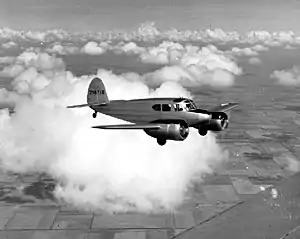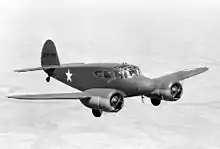Cessna AT-17 Bobcat
The Cessna AT-17 Bobcat is a twin-engined advanced trainer aircraft designed and made in the United States, and used during World War II to bridge the gap between single-engined trainers and twin-engined combat aircraft. The AT-17 was powered by two Jacobs R-755-9 radial engines. The commercial version was the Model T-50, from which the AT-17 was developed.
| AT-17 / UC-78 Bobcat Model T-50 | |
|---|---|
 | |
| Cessna AT-17 Bobcat | |
| Role | Trainer, five-seat light transport and utility aircraft |
| Manufacturer | Cessna Aircraft Company |
| First flight | March 26, 1939 (T-50) |
| Primary users | United States Army Air Forces Royal Canadian Air Force United States Navy |
| Produced | 1939-1944 |
| Number built | 5,422 |
Design and development
.jpg.webp)
In January 1934, Clyde Cessna as company president re-opened his Pawnee Road plant. Joining Cessna were his two nephews, Dwight Wallace as secretary-treasurer, and Dwane Wallace as plant manager. In 1935, Cessna sold out to his nephews, and retired on 8 October 1936. In 1939, the Cessna T-50 Bobcat made its maiden flight, becoming the company's first twin-engine, and retractable landing gear airplane. According to Walt Shiel, "Dwane Wallace, with a mere $5.03 in the corporate bank account, convinced the Royal Canadian Air Force (RCAF) the T-50 would be an ideal training aircraft for bomber pilots." Soon, hundreds of orders came in from the RCAF and the U.S. Army Air Corps.[1]
The AT-17 was a military version of the commercial Cessna T-50 light transport. The Cessna Airplane Company first produced the wood and tubular steel, fabric-covered T-50 in 1939 for the civilian market, as a lightweight and low-cost twin for personal use where larger aircraft such as the Beech 18 would be too expensive. A low-wing cantilever monoplane, it featured retractable main landing gear and wing trailing edge flaps, both electrically actuated via chain-driven screws. The fully retracted main landing gear left half of the wheels extended below the engine nacelle for emergency wheel-up landings. The wing structure was built up of laminated spruce spar beams, truss-style spruce and plywood ribs, and plywood wing leading edges and wing tips. The fixed tailwheel is not steerable and full-swivelling, but can be locked into a fixed centered-orientation. The prototype T-50 made its maiden flight on 26 March 1939.[2] The Curtiss Reed fixed-pitch propellers were then replaced with Hamilton Standard 2B-20-213 hydraulically-actuated, constant-speed, non-featherable propellers, while the 225-horsepower Jacobs L-4MB engines were rated at 245-horsepower for takeoff. Production began in December 1939.[1]:35–36,45–46
On 19 July 1940, United States Assistant Secretary of War Louis A. Johnson awarded Cessna a contract for 33 AT-8s multi-engine trainers, based on the T-50. Modifications included cockpit roof windows, 290-horsepower Lycoming R-680 engines, military radios, and painted aluminum silver. In September 1940, the RCAF ordered 180 Crane I multi-engine trainers, based on the T-50, which was Cessna's largest order to date. Modifications included Hartzell fixed-pitch wooden propellers, removable cylinder head baffles, and oil radiators. Additionally, the CAA ordered 13 T-50s, while Pan American Airways ordered 14 T-50s. The first AT-8 was delivered to the Army in December 1940, while the first Crane I was delivered to the RCAF in November 1940. Cessna then received an additional order from the RCAF for 460 more Crane Is, while in the fall of 1941, the Army Air Force ordered an additional 450 AT-17s, based on the T-50. Modifications included additional cockpit windows, and 245-horsepower Jacobs R-755-9 engines.[1]:36–41
Operational history

Thirty-three AT-8s were built for the U.S. Army Air Corps, and production continued under the designation AT-17 reflecting a change in equipment and engine types. In 1942, the U.S. Army Air Force (the successor to the Air Corps from June 1941) adopted the Bobcat as a light personnel transport and those delivered after January 1, 1943 were designated UC-78s. By the end of World War II, Cessna had produced more than 4,600 Bobcats for the U.S. military, 67 of which were transferred to the United States Navy as JRC-1s. In addition, 822 Bobcats had been produced for the Royal Canadian Air Force as Crane Is, many of which were used in the British Commonwealth Air Training Plan.[3] The aircraft did not last long in North American postwar military service. Few (if any) Bobcats were in service with the United States Air Force when it was formed in September, 1947. Surviving military aircraft were declared obsolete in 1949.[4]
Dubbed the "Bamboo Bomber" by the pilots who flew them, it was one of the aircraft featured in the popular television series Sky King of the early-to-mid 1950s.[1]:44–45 The aircraft was replaced in later episodes by the T-50's successor, the all-metal Cessna 310.
After the war, surplus AT-17s and UC-78s could be converted by CAA-approved kits to civilian-standard aircraft allowing their certification under the T-50s original Type Certificate (ATC- 722, issued 3-24-1940).[5] They were used by small airlines, charter and "bush" operators and private pilots. Some were operated on floats. By the 1970s, the number of airworthy aircraft had dwindled as they were made obsolete by more modern types and by the maintenance required by their aging wood wing structures and fabric covering. Since then, several have been restored by antique airplane enthusiasts.
As of December 2017, FAA records show 52 T-50s, two AT-17s, and five UC-78s listed on its registration database.[6][7][8]
In the postwar years, Bobcats continued in military service with Brazil and the Nationalist Chinese.
Variants

- T-50
- Company design number. Five-seat twin-engined commercial transport aircraft, fitted with Jacobs L-4MB radial piston engines.
- AT-8
- Military trainer version of the T-50 with two 295 hp (220-kW) Lycoming R-680-9 radial piston engines, 33 built.
- AT-17
- As the AT-8 but powered by 245 hp (183 kW) Jacobs R-755-9 (L-4) engines, 450 built some later converted to AT-17E.
- AT-17A
- As the AT-17 but with metal propellers and reduced weight, 223 built. 182 to Canada as Crane IAs and later conversion to AT-17Fs.
- AT-17B
- As the AT-17A but with equipment changes, 466 built. Subsequent aircraft were built as UC-78Bs.
- AT-17C
- As the AT-17A but different radio equipment, 60 built.
- AT-17D
- As the AT-C with equipment changes, 131 built.
- AT-17E
- AT-17 with gross weight limited to 5,300 lb (2,400 kg).

- AT-17F
- AT-17A with gross weight limited to 5,300 lb (2,400 kg).
- AT-17G
- AT-17B with gross weight limited to 5,300 lb (2,400 kg).
- C-78
- Military transport version for the United States Army Air Forces, redesignated UC-78 in 1943, 1354 built.
- UC-78
- C-78 redesignated in 1943; variable-pitch propellers.
- UC-78A
- 17 impressed civilian T-50s
- UC-78B
- Originally the AT-17B, wooden propellers and reduced weight, 1806 built.

- UC-78C
- Originally the AT-17D, same as UC-78B with equipment changes, 196 built and 131 AT-17Ds redesignated.
- JRC-1
- Navy light transport version of the UC-78 with two Jacobs -9 engines, 67 delivered.
- Crane I
- Royal Canadian Air Force designation for T-50s with minor equipment changes, 640 delivered as light transports.
- Crane 1A
- 182 AT-17As delivered to Canada under lend-lease.
- P-7
- An experimental variant of the T-50 with more powerful 300 hp (220 kW) Jacobs L-6MB engines, and plywood covered tailplane and wings, one aircraft only first flown June 2, 1941.
- P-10
- 1941 advanced bomber trainer with modified fuselage, sliding canopy and 330 hp (250 kW) Jacobs engines, 1 built.[9]
Operators
- Brazilian Air Force (operated 39 from 1943 to 1956)
- Royal Canadian Air Force (operated 744 from 1941 to 1949)
- Queen Charlotte Airlines
- Air Force of Costa Rica (operated one in 1948)
- Ethiopian Air Force (operated two from 1946 to 1965)
- French Air Force and French Navy (operated eight from 1943 to 1951)
- Guatemalan Air Force (received one in 1949)
- Haitian Air Force (operated four from 1943 to 1995)
- Nicaraguan Air Force (received two in 1947)
- Yemeni Air Force (operated three from 1950 to 1958)
- Republic of China Air Force (operated 15 from 1946 to 1950)
- Peruvian Air Force (operated nine from 1945 to 1958)
- LOT Polish Airlines (operated 14 in 1946-1950, reg. nos: SP-LEA to LEO)[10]
Specifications (AT-17)
General characteristics
- Crew: pilot+four
- Length: 32 ft 9 in (9.98 m)
- Wingspan: 41 ft 11 in (12.78 m)
- Height: 9 ft 11 in (3.02 m)
- Wing area: 295 sq ft (27.4 m2)
- Empty weight: 3,500 lb (1,588 kg)
- Gross weight: 5,700 lb (2,585 kg)
- Max takeoff weight: 6,062 lb (2,750 kg)
- Powerplant: 2 × Jacobs R-755-9 seven-cylinder, air-cooled, radial piston engine, 245 hp (183 kW) each
Performance
- Maximum speed: 169 kn (195 mph, 314 km/h)
- Cruise speed: 152 kn (175 mph, 282 km/h)
- Stall speed: 55–57 kn (63–66 mph, 101–106 km/h)
- Range: 650 nmi (750 mi, 1,210 km)
- Service ceiling: 22,000 ft (6,700 m)
- Rate of climb: 1,150 ft/min (5.8 m/s)
- Take-off run to 50 ft (15 m) at 5200 lb gross weight: 650 ft (200 m)
- Landing run from 50 ft (15 m) at 5200 lb gross weight and 90 mph approach speed: 1,400 ft (430 m)
See also
Aircraft of comparable role, configuration, and era
Related lists
References
Notes
- Shiel, Walt (1995). Cessna Warbirds, A Detailed & Personal History of Cessna's Involvement in the Armed Forces. Iola: Jones Publishing, Inc. pp. 15–16. ISBN 9781879825253.
- Wixley 1984, p.13.
- Phillips, Edward H: Cessna, A Master's Expression, Flying Books, 1985. ISBN 0911139044
- Swanborough, Gordon & Bowers, Peter M: United States Military Aircraft Since 1909, Putnam, 1989. ISBN 0-85177-816-X
- Juptner, Joseph P: U.S. Civil Aircraft Series, Vol 8, TAB Books, 1994. ISBN 0-8168-9178-8
- "FAA Registry - Aircraft - Make / Model Inquiry". faa.gov. Retrieved 11 June 2016.
- "FAA Registry - Aircraft - Make / Model Inquiry". faa.gov. Retrieved 11 June 2016.
- "FAA Registry - Aircraft - Make / Model Inquiry". faa.gov. Retrieved 11 June 2016.
- "Cessna: P-10". aerofiles. Retrieved 15 September 2018.
- Jońca, Adam (1985). Samoloty linii lotniczych 1945-1956, Barwa w lotnictwie polskim no.4, WKiŁ, Warsaw, ISBN 83-206-0529-6 (in Polish), p.12
- Bridgman 1952, p. 28.
Bibliography
- Bridgman, Leonard. Jane's All the World's Aircraft 1952–53. London: Sampson Low, Marston & Company, Ltd., 1952.
- Mondey, David. American Aircraft of World War II (Hamlyn Concise Guide). London: Bounty Books, 2006. ISBN 978-0-7537-1461-4.
- Wixley, Kenneth E. "Cessna Bobcat:A Production History". Aircraft Illustrated, January 1984, Vol 17 No 1, pp. 13–16. ISSN 0002-2675.
- "Cessna Model T-50". Aviation. Vol. 39 no. 1. January 1940. pp. 46–47.
External links
| Wikimedia Commons has media related to Cessna T-50. |